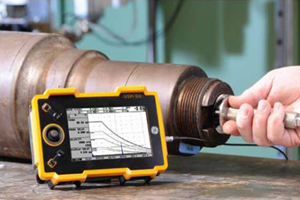Ultrasonic control is a material control method using high frequency sound waves. High-frequency sound waves are sent into the material to be controlled. At this time, sound waves reflect if they encounter an obstacle in their path. At this time, the reflected signals, depending on the angle of impact, produce wave lines on the screen of the ultrasonic control means. With these values, both the coordinates of the obstacle in the material are calculated and the size of the obstacle emerges according to the height of the waves. It is even possible to get an idea of the type of obstacle.
By testing pressure equipment in this way, volumetric errors and crack-like surface defects can be detected. Ultrasonic inspection and testing Several methods are used in the process. For example, high-frequency transmission from a certain point to the pressure equipment to be examined by conduction and reflection method sound waves Sent. These waves appear in echoes on the display of the controller. By monitoring these echoes, it is determined whether there is an error in the pressure equipment.
In the resonance method, the frequency sound waves sent on the pressure vessels to be examined are not constant. Ultrasonic examination When the frequency of the sound waves from the medium is the same as the natural frequency of the pressure vessels, the width increases. This increase in width is determined by the distance between the wavelengths of the echoes reflected on the screen of the ultrasonic examination device. This method is also used for measuring the thickness of pressure vessels with parallel surfaces.
Regarding pressure vessels, the 97 / 23 / EC Pressure Equipment Directive has been issued under the New Approach Directives in the European Union. In our case, the Ministry of Industry and Trade is based on this directive. Regulation on Pressure Equipment'. The specifications, criteria and relevant standards of pressure equipment are described in this regulation and its annexes.
The most common types of waves used in ultrasonic testing are longitudinal (pressure) and transverse (shear) waves. The waves that travel through the pressure vessels during the test are longitudinal waves, ie pressure waves.
The measurements that can be done in ultrasonic testing and inspection are as follows:
- Size (thickness)
- Length and thickness
- Ultrasonic thermometer (size change at temperature)
- Surface hardness
- Determination of properties
- Grain size, decomposing phases, residues, cold and hot grades
- Determination of internal stresses
- Fault detection
Whichever method is applied, ultrasonic examination and tests have certain advantages. For example, errors of pressure vessels can be detected in three dimensions. It is sensitive to the detection of errors. These tests are easy to implement. Does not require the use of excess consumables. Particularly in thick pressure vessels, planar errors can be detected more precisely.
The TÜRCERT certification body provides conformity assessment, certification and training services, while providing testing and inspection services. Pressure equipment ultrasonic thickness measurements are one of the services provided in this way. Do not hesitate to contact the experienced managers and employees of the TÜRCERT certification body for further information on ultrasonic testing and testing of pressure vessels.

